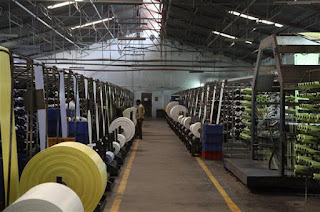How to decide GSM of FIBC bags?
Detailed Guide to Determining the GSM of FIBC Bags
Deciding the GSM (grams per square meter) for Flexible
Intermediate Bulk Containers (FIBCs) involves a thorough understanding of the
bag’s intended application, safety requirements, material characteristics, and
industry standards. Here’s an in-depth step-by-step guide:
1. Understand the Usage Requirements
Load Capacity
- Maximum
Weight: Identify the maximum weight the FIBC needs to support. FIBCs
are designed to handle loads ranging from 500 kg to 2000 kg or more.
- Dynamic
Load: Consider if the bag will experience dynamic loading during
transportation or handling, which can affect the required strength.
Product Type
- Particle
Size: The type of material being stored affects the choice of fabric.
Fine powders may require coated fabric to prevent leakage, whereas coarse
materials may not.
- Chemical
Properties: Determine if the product is chemically reactive or
abrasive, which may necessitate specific fabric treatments.
Handling Conditions
- Loading
and Unloading: Assess how the bags will be loaded and unloaded. Bags
handled by forklifts or cranes may require higher strength and durability.
- Transport:
Consider the transport method (e.g., truck, ship, rail) and the conditions
(e.g., vibrations, impacts).
2. Consider Safety Factors
Safety Factor (SF)
- Common
Ratings: FIBCs typically have a safety factor of 5:1 or 6:1. This
means a bag designed to hold 1000 kg should theoretically hold up to 5000
or 6000 kg in ideal conditions without failing.
- Application:
Higher safety factors are needed for critical applications such as
handling hazardous materials.
Regulations and Standards
- ISO
21898: This standard specifies requirements for FIBCs, including
safety factors, testing procedures, and performance criteria.
- Other
Standards: Be aware of other relevant standards such as ASTM, UN
regulations for hazardous materials, and customer-specific requirements.
3. Determine Material Properties
Fabric Type
- Woven
Polypropylene: The most common material used for FIBCs. Its strength
and flexibility make it suitable for a wide range of applications.
- Fabric
Weave: The weave pattern affects the strength and permeability of the
fabric. Tight weaves provide more strength and are suitable for fine
powders.
Coatings and Liners
- Coated
vs. Uncoated: Coated fabrics provide additional protection against
moisture and fine particle leakage. Typically, coatings add 10-20 GSM.
- Liners:
For sensitive products, an inner liner may be required, which adds to the
overall GSM.
UV Resistance
- Outdoor
Storage: If bags will be stored outside, UV stabilizers are necessary
to prevent degradation from sunlight. UV treatment can add to the cost and
GSM.
4. Calculate the Required GSM
Base Fabric GSM
- Load-based
Calculation: Start with a base fabric GSM suitable for the intended
load. For instance, a 1000 kg capacity bag typically starts with a base
fabric GSM of 160-220.
- Strength
Requirements: Higher load capacities or more rigorous handling
conditions will require higher GSM fabrics.
Layer Additions
- Coatings:
Add the GSM of any coatings. For example, if a 15 GSM coating is needed,
it will be added to the base fabric GSM.
- Reinforcements:
Consider any additional reinforcements, such as extra fabric in critical
areas like lifting loops, which can increase the GSM.
Example Calculation
For a standard FIBC bag with a 1000 kg capacity:
- Base
Fabric: Choose 180 GSM fabric.
- Coating:
Add 15 GSM for coating.
- Total
GSM: 180 GSM + 15 GSM = 195 GSM.
5. Finalize and Test
Sample Production
- Prototype:
Produce a sample FIBC based on the calculated GSM.
- Testing:
Conduct rigorous testing under simulated real-world conditions, including
loading, unloading, transportation, and environmental exposure.
Adjustments
- Performance
Review: Evaluate the sample’s performance. If the bag doesn’t meet the
required performance or safety standards, adjust the GSM accordingly.
- Iterative
Process: It may take several iterations to achieve the optimal balance
of strength, safety, and cost.
Summary
- Load
Capacity & Usage: Determine the weight and type of material to be
stored.
- Safety
Factors: Ensure compliance with safety factor ratings and regulatory
standards.
- Material
Selection: Choose appropriate fabric type, coating, and UV resistance.
- GSM
Calculation: Calculate total GSM considering base fabric and
additional layers.
- Testing:
Produce, test, and refine the FIBC to ensure it meets all requirements.
By following these detailed steps, you can determine the
appropriate GSM for your FIBC bags, ensuring they are safe, durable, and fit
for their intended purpose.




great
ReplyDeleteWhether for retail, bulk storage, or transport, PP Woven Bags combine functionality with eco-friendliness, making them a preferred choice in today's market.
ReplyDeleteAmazing
ReplyDelete